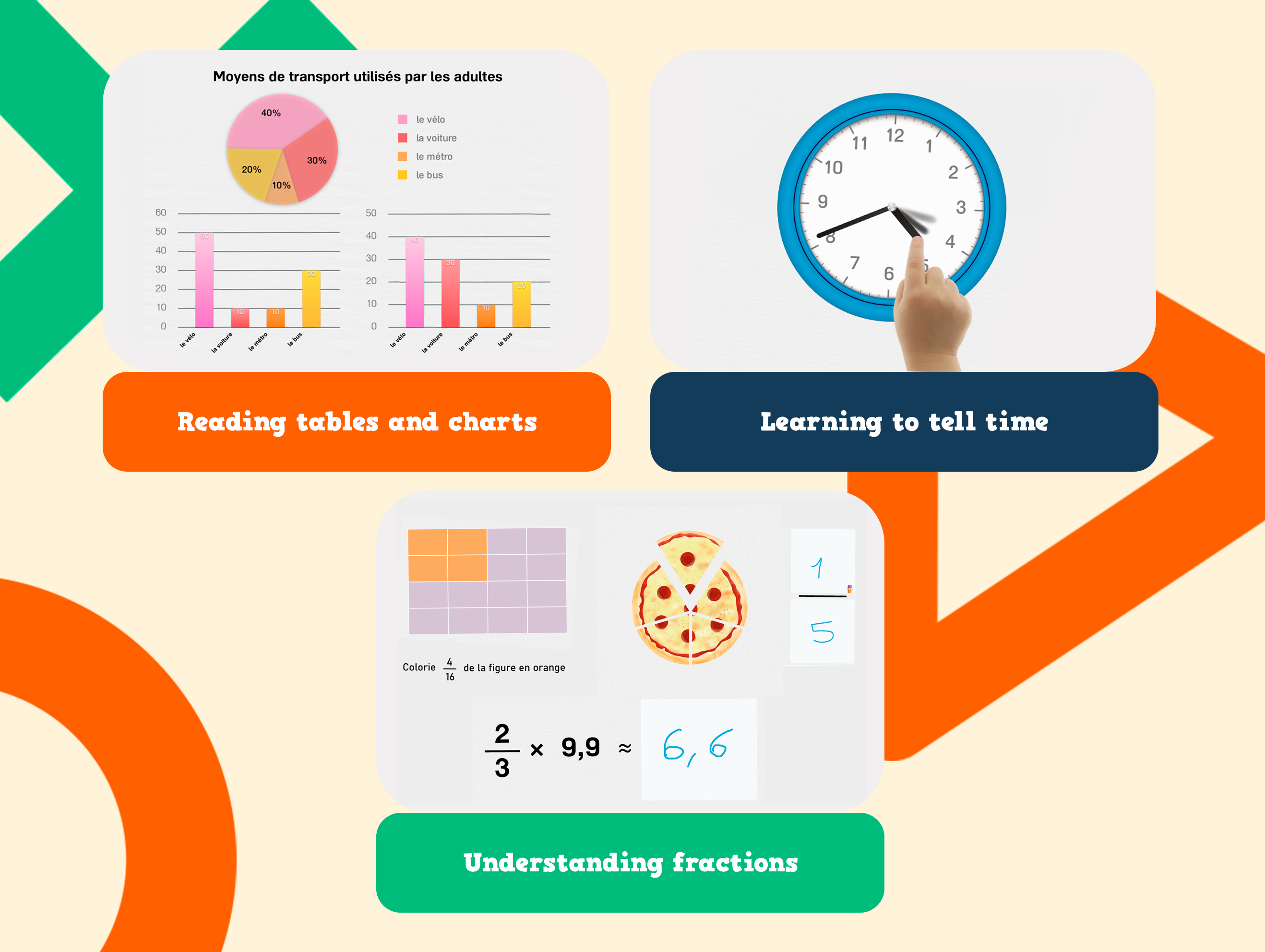
Exercises to Learn How to Tell Time in 3rd Grade
Learn to tell time easily with myBlee Math’s fun exercises. Interactive activities, animated clocks, and clear explanations help students progress at their own pace, from 1st to 5th grade.
3rd Grade Math Exercises to Learn How to Tell Time
Learning to tell time is one of the key steps in the learning of time in 3rd grade. With our step-by-step exercises, children practice identifying time, understanding what the short hand indicates, distinguishing full hours, half-hours, quarter-hours, and reading both analog and digital clocks.
Each activity is designed to support students from 1st to 2nd grade and then in 3rd grade, with clear and playful instructions. Because it is better to to move at one’s own pace, our worksheets provide a structured learning of time, connected to other math skills like number reading, mental calculation, or problem solving.
An excellent tool for learning to tell time at home or in class, while tracking progress.
Why Learning to Tell Time Is Important in 3rd Grade
Telling time is not limited to reading a clock: it helps children structure their relationship with time and organize their day. In 3rd grade, this skill is part of a broader learning path tied to time management, autonomy, and understanding activity sequences.
It’s also a great exercise in focus, visual tracking, and linking units (hours, minutes) to values. By gradually mastering full hours, half-hours, or quarter-hours, the student develops a finer perception of passing time, useful both at school and in everyday life.
Step-by-Step Exercises to Learn to Tell Time with Confidence
Since every child progresses at their own pace, our time-telling exercises are designed to adapt to different levels of mastery. Whether just starting or needing to reinforce prior learning, each set of exercises offers a logical and reassuring progression.
Fill-in-the-clock tasks, matching activities, short everyday stories to decode: the variety keeps attention high and boosts understanding. Without pressure, the child learns to identify full hours, half-hours, and quarter-hours, recognize the role of the hands, and get familiar with concrete time references.
Thousands of Math Exercises to Download and Practice Anytime
To easily learn how to tell time, there’s nothing better than regular practice. Our downloadable exercises cover all stages of time learning: full hours, half-hours, quarter-hours, reading the clock, and understanding what the short hand shows.
These printable worksheets are perfect for reviewing at home or reinforcing learning in class, from 1st to 6th grade. Thanks to a clear progression and accessible instructions, each child can learn to tell time at their own pace and navigate time independently.

Hundreds of Printable PDF Worksheets to Improve Math Skills from 1st to 6th Grade
The myBlee Math app offers a wide range of downloadable PDF worksheets, designed to support students from 1st to 6th grade throughout their math learning journey. Sorted by level and concept, they cover the main curriculum skills: numbers, operations, geometry, fractions, mental math, as well as cross-disciplinary areas like measurements and magnitudes, which includes telling time.
Each worksheet is designed to be used independently, both at school and at home. Children can practice telling time, recognize what the short and long hands indicate, distinguish full hours, half-hours, and quarter-hours, or associate a time with a daily activity.
Thanks to clear progression and tailored instructions, these resources help reinforce learning, fill in gaps, or simply review in a structured way. With myBlee Math, the student progresses at their own pace, develops logic, and gains confidence in their ability to understand and use math in daily life.
Frequently Asked Questions About Learning to Tell Time
Learning to tell time is one of the major steps toward autonomy in children. Whether on an analog or digital clock, it takes time, patience, and some reference points. Here are answers to the most common questions about this learning process.
How do you tell time on a clock?
To tell time on an analog clock, first look at the short hand (hours), then the long hand (minutes). Each number represents an hour, and each space between two numbers equals 5 minutes.
At what age do children learn to tell time?
Most children start learning to tell time around age 6 or 7, often in 2nd grade. But it varies for each child: some learn earlier, others need more time.
How can I teach my child to tell time?
To teach your child to tell time, start by explaining the hands and what they do. Use a clock with real hands, play with daily schedules, and go step by step, making the learning fun and concrete.
Why learn to tell time?
Learning to tell time helps children understand their day, grasp the flow of time, and become more autonomous. It’s an essential skill for organizing activities and following daily routines.